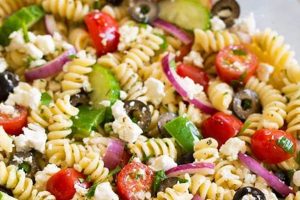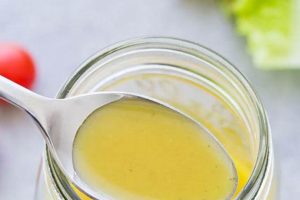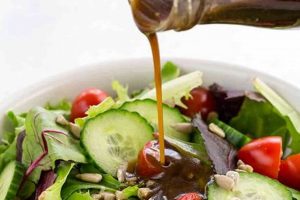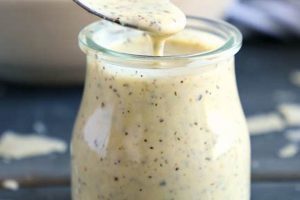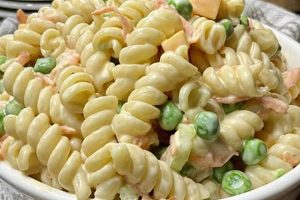A classic Caesar dressing typically features a base of emulsified egg yolks, oil, lemon juice, garlic, and seasonings. Mayonnaise, a pre-made emulsion of oil and egg yolks, often serves as a convenient shortcut, providing a creamy texture and tangy flavor profile. A recipe incorporating this ingredient streamlines the preparation process, eliminating the need to emulsify ingredients from scratch. For example, a simple version might combine mayonnaise with minced garlic, anchovy paste, lemon juice, Parmesan cheese, and black pepper.
Utilizing this prepared ingredient offers several advantages. It saves time and effort, ensuring a consistent emulsion without the risk of the dressing breaking. The pre-existing flavors in the mayonnaise contribute to the overall complexity of the dressing, complementing the other ingredients. Historically, some believe that early versions of Caesar dressing were made with mayonnaise or a mayonnaise-like ingredient, adding a layer of authenticity to this approach. This ease of use and flavor contribution makes it a popular choice for both home cooks and professional chefs.
This foundation facilitates exploration of various recipe variations. From classic preparations to modern interpretations with unique ingredients and flavor profiles, the possibilities are numerous. Examining different techniques, ingredient choices, and flavor combinations provides a deeper understanding of how to create a perfect Caesar dressing tailored to individual preferences.
Tips for Caesar Dressing Recipes Utilizing Mayonnaise
The following tips offer guidance on enhancing Caesar dressings made with mayonnaise, ensuring optimal flavor and texture.
Tip 1: Emulsion Stability: Adding a small amount of Dijon mustard can aid in stabilizing the emulsion, preventing separation and maintaining a creamy consistency.
Tip 2: Flavor Enhancement: Anchovy paste provides a savory depth. Start with a small amount and adjust according to taste preferences.
Tip 3: Acidity Balance: Freshly squeezed lemon juice offers superior flavor compared to bottled varieties and balances the richness of the mayonnaise.
Tip 4: Garlic Integration: Finely minced or grated garlic infuses a more pungent flavor than larger pieces. Roasting the garlic mellows its intensity.
Tip 5: Parmesan Quality: Freshly grated Parmesan cheese offers a superior flavor and texture compared to pre-grated alternatives.
Tip 6: Seasoning Adjustment: Freshly ground black pepper adds a subtle heat. Sea salt enhances the overall flavor profile. Adjust seasonings gradually to achieve desired results.
Tip 7: Ingredient Incorporation: Whisk ingredients together thoroughly to ensure proper emulsification and even distribution of flavors.
By following these tips, one can achieve a well-balanced and flavorful Caesar dressing with a smooth, creamy texture, elevating any salad.
These practical suggestions facilitate creating a dressing tailored to individual preferences, leading to a more satisfying culinary experience.
1. Mayonnaise (base)
Mayonnaise serves as the foundational element in Caesar dressings utilizing this ingredient. Its emulsion of oil and egg yolks provides the characteristic creamy texture and rich mouthfeel essential for a successful dressing. This base acts as a binding agent, bringing together the disparate flavors of garlic, anchovy, lemon juice, and cheese. Without a stable mayonnaise base, the dressing risks separation and lacks the desired consistency. This crucial role impacts both the final taste and textural experience. Consider, for example, the difference between a cohesive, creamy dressing and one that is thin and watery. The stability provided by mayonnaise ensures the flavors meld harmoniously and cling to the salad greens.
The quality of the mayonnaise directly influences the overall quality of the dressing. A mayonnaise made with high-quality oils offers a superior flavor profile compared to one made with lower-quality oils. Similarly, the ratio of oil to egg yolks impacts the thickness and richness. A higher proportion of oil results in a thinner dressing, while a higher proportion of egg yolks produces a thicker, richer result. Understanding this balance enables one to tailor the dressing consistency to specific preferences. In practical application, this might involve selecting a thicker mayonnaise for a heartier salad with robust greens or a thinner mayonnaise for more delicate leaves. Furthermore, the mayonnaise itself can be flavored, offering opportunities for customization, such as incorporating infused oils or roasted garlic.
A stable, flavorful mayonnaise base is paramount for a successful Caesar dressing. The quality and composition of this ingredient directly impact the final product’s texture, flavor, and overall enjoyment. Mastering this foundational component allows for greater control over the finished dish, contributing to a more satisfying culinary outcome. Further exploration of mayonnaise variations and their effects on the dressing can enhance one’s culinary expertise and unlock creative possibilities within the Caesar salad realm.
2. Lemon juice (acidity)
Lemon juice provides essential acidity, balancing the richness of mayonnaise and other ingredients within a Caesar dressing. This acidity plays several crucial roles. It brightens the overall flavor profile, cutting through the fattiness of the mayonnaise and creating a more balanced, palatable dressing. Furthermore, the acidity acts as a preservative, extending the shelf life of the dressing. From a culinary perspective, the sharpness of lemon juice complements the savory notes of the anchovies and Parmesan cheese, enhancing their individual flavors while creating a harmonious blend. Consider, for example, the difference between a Caesar dressing made with and without lemon juice. The version lacking acidity would taste flat and overly rich, while the one with lemon juice offers a refreshing contrast and heightened flavor complexity. This balance is crucial for a well-rounded and enjoyable Caesar salad experience.
The type and amount of lemon juice used can significantly impact the final dressing. Freshly squeezed lemon juice is preferred due to its superior flavor and higher acidity compared to bottled varieties. The concentration of citric acid in lemons can vary, influencing the necessary amount for optimal balance. A dressing made with less acidic lemon juice might require a larger quantity to achieve the desired brightness, while using an excessively tart lemon juice could overpower the other flavors. Practical application involves tasting and adjusting the amount of lemon juice based on the specific ingredients and individual preferences. One might start with a standard amount and then incrementally add more, tasting after each addition, until the desired balance is achieved. This iterative approach allows for precise control over the final flavor profile.
Achieving the correct acidity level within a Caesar dressing is essential for both flavor and preservation. Lemon juice serves as a key component, balancing the richness of the mayonnaise and other ingredients. Understanding its role and utilizing fresh, high-quality lemon juice empowers one to create a vibrant, flavorful, and well-balanced Caesar dressing. This careful attention to acidity enhances the overall dining experience and contributes to a more sophisticated culinary outcome.
3. Garlic (pungency)
Garlic contributes a pungent, savory depth crucial to the flavor profile of Caesar salad dressing made with mayonnaise. Its sharp, aromatic notes cut through the richness of the mayonnaise and other ingredients, adding a layer of complexity. The intensity of this pungency influences the overall balance and character of the dressing. For example, a dressing with a pronounced garlic flavor offers a bold, assertive taste, while a dressing with subtly integrated garlic provides a milder, more nuanced experience. This balance hinges on both the type of garlic used and its preparation method.
Several factors influence the final expression of garlic’s pungency within the dressing. Raw garlic delivers the most intense flavor, while roasted garlic offers a mellower, sweeter profile. Furthermore, the method of preparation, such as mincing, pressing, or grating, impacts the release of flavorful compounds. Mincing creates distinct pieces of garlic, while pressing or grating releases more of the volatile oils responsible for the characteristic pungency. Practical applications of this understanding include adjusting the type and preparation of garlic to tailor the dressing to specific taste preferences. One might opt for roasted garlic to complement a lighter, more delicate Caesar salad, while raw, minced garlic might suit a more robust salad featuring bolder flavors.
Harnessing the pungency of garlic is essential for a well-balanced and flavorful Caesar dressing. Understanding the impact of preparation methods and varietal choices allows for precise control over the final flavor profile. This knowledge enables customization based on individual preferences and the overall composition of the salad, ensuring a more satisfying and tailored culinary experience.
4. Parmesan (sharpness)
Parmesan cheese contributes a sharp, salty, umami-rich dimension to Caesar salad dressings utilizing mayonnaise. This sharpness arises from the cheese’s long aging process, during which proteins break down into amino acids, notably glutamate, which imparts the characteristic savory flavor. The intensity of this sharpness is directly related to the age and quality of the Parmesan. A well-aged, high-quality Parmesan provides a more pronounced and complex flavor profile compared to younger or lower-quality cheeses. This sharpness plays a critical role in balancing the richness of the mayonnaise and other ingredients, preventing the dressing from becoming overly heavy or cloying. Consider, for example, a Caesar dressing made with a bland, young cheese. The dressing would lack depth and complexity, likely tasting flat and one-dimensional. Conversely, a dressing made with aged Parmesan offers a well-rounded flavor experience with a pronounced savory character.
The form in which Parmesan is incorporated also influences its impact on the dressing. Freshly grated Parmesan offers superior flavor and texture due to its larger surface area, allowing for better integration and flavor release. Pre-grated Parmesan often contains cellulose powder, which can hinder its ability to melt and fully incorporate into the dressing, potentially resulting in a gritty texture. Furthermore, the amount of Parmesan used affects the overall sharpness and saltiness of the dressing. Adding too much Parmesan can overpower the other flavors and make the dressing excessively salty, while too little Parmesan can leave the dressing lacking depth. Practical applications of this knowledge involve selecting high-quality, aged Parmesan and grating it fresh just before incorporating it into the dressing. Careful consideration of the quantity used allows for precise control over the final flavor profile and ensures optimal integration into the emulsion.
The sharpness of Parmesan is indispensable for a well-balanced and flavorful Caesar dressing. Its complex savory notes, derived from the aging process and amplified by proper preparation, complement the other ingredients, creating a harmonious and dynamic flavor profile. Understanding the role of Parmesan’s sharpness, selecting appropriate cheeses, and utilizing proper grating techniques are essential for crafting a superior Caesar dressing and achieving a truly satisfying culinary experience.
5. Anchovies (umami)
Anchovies play a crucial role in Caesar salad dressing, contributing a distinct umami richness that significantly enhances complexity and depth. This savory element, often misunderstood, forms an integral part of the dressing’s characteristic flavor profile, complementing the other ingredients and providing a unique, satisfying taste experience. Understanding the role of anchovies is essential for fully appreciating and replicating authentic Caesar dressing.
- Umami and Flavor Enhancement
Umami, often described as the fifth taste, adds a savory depth and complexity beyond the traditional sweet, sour, salty, and bitter tastes. Anchovies, rich in glutamate, a key amino acid responsible for umami, contribute this savory dimension to Caesar dressing. This umami note enhances the other flavors present, making them more pronounced and balanced. For example, the sharpness of Parmesan cheese and the tang of lemon juice are both amplified by the presence of anchovy-derived umami, creating a more harmonious and flavorful overall experience. This synergistic effect elevates the dressing beyond a simple combination of ingredients into a complex and layered culinary creation.
- Anchovy Forms and Incorporation
Anchovies can be incorporated into Caesar dressing in various forms, each offering a slightly different flavor profile and intensity. Traditional recipes often utilize whole anchovy fillets, finely minced or mashed. Anchovy paste provides a more concentrated flavor and smoother integration, while anchovy-flavored oil offers a subtler umami note. The choice of form depends on personal preference and the desired intensity of anchovy flavor. For instance, using whole fillets allows for visual identification of the ingredient, while anchovy paste seamlessly blends into the dressing, providing a consistent flavor throughout. Understanding these nuances allows for greater control over the final flavor profile and caters to diverse culinary preferences.
- Balancing Anchovy Flavor
While crucial for umami, the anchovy flavor should be balanced within the overall composition of the dressing. Too much anchovy can overpower the other flavors, creating a fishy or overly salty taste. Careful portioning and integration are essential for achieving a harmonious blend. The acidity of lemon juice and the sharpness of Parmesan cheese play crucial roles in balancing the intensity of the anchovies. For example, increasing the amount of lemon juice can help cut through the richness of the anchovies, while adjusting the quantity of Parmesan can fine-tune the overall saltiness and umami balance. This careful balancing act ensures the anchovy flavor enhances the dressing without dominating it.
- Anchovy Alternatives and Substitutions
For those who avoid anchovies due to dietary restrictions or personal preferences, alternatives exist to achieve a similar umami boost. Ingredients like Worcestershire sauce, fish sauce, or even dried seaweed can contribute savory notes, albeit with slightly different flavor profiles. While these alternatives may not perfectly replicate the unique flavor of anchovies, they offer viable options for achieving a similar depth and complexity. For example, Worcestershire sauce, containing fermented anchovies among other ingredients, can provide a comparable umami richness, while fish sauce offers a more intense, briny flavor. Understanding these alternatives allows for customization and adaptability in Caesar dressing preparation.
The nuanced role of anchovies in Caesar salad dressing highlights the importance of understanding ingredient interactions and flavor balancing. Anchovies contribute a unique umami richness that elevates the dressing’s complexity, creating a harmonious and satisfying flavor profile. Mastering the incorporation and balance of this ingredient is crucial for achieving an authentic and flavorful Caesar salad experience.
6. Black pepper (spice)
Black pepper provides a crucial element of spice and complexity to Caesar salad dressings based on mayonnaise. Its contribution extends beyond simple heat, adding depth and nuance to the overall flavor profile. Freshly ground black peppercorns offer superior flavor and aroma compared to pre-ground pepper due to the volatile oils released during grinding. These oils contain piperine, the compound responsible for pepper’s characteristic pungency. This freshly ground spice complements the rich, savory notes of the mayonnaise, anchovies, and Parmesan, creating a balanced and harmonious flavor experience. For example, a dressing lacking black pepper might taste flat and one-dimensional, whereas the subtle heat and complexity introduced by freshly ground pepper elevate the other ingredients, creating a more nuanced and satisfying sensory experience. The quantity of black pepper used influences the final flavor profile, ranging from a subtle background note to a more pronounced spiciness, allowing for customization according to individual preferences.
The interplay between black pepper and other Caesar dressing ingredients creates a dynamic flavor profile. The acidity of lemon juice moderates the pepper’s heat, preventing it from becoming overpowering. Simultaneously, the richness of the mayonnaise and the umami notes of the anchovies and Parmesan create a backdrop against which the pepper’s spiciness can shine. This delicate balance is essential for a well-rounded Caesar dressing. Consider the impact of using pre-ground pepper versus freshly ground peppercorns. Pre-ground pepper, having lost many of its volatile oils, delivers a duller, less impactful flavor, while freshly ground peppercorns provide a vibrant, pungent note that enhances the overall sensory experience. This difference underscores the importance of ingredient quality and freshness in achieving optimal flavor.
Black pepper’s role, while seemingly minor, significantly impacts the overall flavor profile of Caesar salad dressing made with mayonnaise. Its pungency and complexity, best achieved through freshly ground peppercorns, add depth and balance to the rich and savory notes of the other ingredients. Understanding the interplay between black pepper and the other components allows for precise control over the final flavor profile, contributing to a more refined and enjoyable culinary experience. Failing to consider this element can result in a less dynamic and satisfying dressing, underscoring the importance of attention to detail in culinary endeavors.
Frequently Asked Questions
This section addresses common inquiries regarding Caesar salad dressing recipes utilizing mayonnaise.
Question 1: Does using mayonnaise compromise the authenticity of Caesar salad dressing?
While traditional recipes typically involve emulsifying raw egg yolks with oil, historical accounts suggest that early versions of Caesar dressing might have incorporated mayonnaise or a mayonnaise-like ingredient. Therefore, utilizing mayonnaise can be considered a valid approach with potential historical precedent.
Question 2: What type of mayonnaise is best suited for Caesar dressing?
High-quality mayonnaise made with neutral-flavored oil, such as canola or grapeseed, allows the other flavors to shine. Avoid mayonnaise with strong flavors that might clash with the dressing’s intended profile.
Question 3: How can one prevent Caesar dressing made with mayonnaise from becoming too thick?
Adding small amounts of water, lemon juice, or even the brine from the anchovies can adjust the consistency without compromising the flavor.
Question 4: Can Caesar dressing made with mayonnaise be stored, and for how long?
Refrigeration in an airtight container allows for storage up to three days. However, the emulsion may break down slightly over time, affecting texture.
Question 5: How does the use of mayonnaise impact the nutritional value of Caesar dressing?
Mayonnaise contributes fat and calories. However, careful portioning and the use of lighter mayonnaise options can mitigate this impact.
Question 6: How can one adjust the flavor of Caesar dressing made with mayonnaise to personal preference?
Adjusting ingredients like lemon juice, garlic, anchovy paste, and black pepper allows for customized flavor profiles. Start with small adjustments and taste frequently to achieve the desired balance.
Careful selection of ingredients and attention to detail ensure a delicious and satisfying Caesar dressing experience. Addressing common concerns about authenticity, texture, storage, and flavor customization empowers one to confidently create flavorful dressings.
This FAQ section provides a foundation for further exploration of recipe variations and techniques, leading to a deeper understanding of Caesar salad dressing preparation.
Caesar Salad Dressing Recipe Mayo
Exploration of Caesar salad dressing recipes utilizing mayonnaise reveals the crucial role of this ingredient in achieving desired texture and flavor. Mayonnaise provides a stable emulsion, binding together diverse ingredients like lemon juice, garlic, Parmesan cheese, and anchovies. The quality of mayonnaise influences the final outcome, impacting both flavor and texture. Balancing acidity, pungency, sharpness, and umami is essential for a successful dressing. Freshly ground black pepper enhances complexity, while careful ingredient selection and preparation optimize flavor profiles. Addressing common concerns regarding authenticity and adaptability further clarifies the utility of mayonnaise in Caesar salad dressing preparation.
Culinary exploration requires continuous refinement and adaptation. Understanding the nuances of each ingredient’s contribution empowers informed decision-making in recipe development and execution. The seemingly simple Caesar salad dressing offers a canvas for creativity and exploration, with mayonnaise serving as a versatile foundation for crafting personalized and satisfying culinary experiences.

